Just as the Leakeys thought, Olduvai Gorge with its stone tool assemblages was a good place to search for human ancestors. Part of what is now Olduvai Gorge was once a lake. Almost 2 mya, its shores were inhabited by numerous wild animals including a variety of bipeds. In 1959—when the Leakeys found the bones of the first specimen of robust Australopithecus boisei in association with some of these tools and the bones of birds, reptiles, antelopes, and pigs— they thought they had found the remains of one of the toolmakers. Fossils unearthed a few months later and a few feet below this first discovery led them to change their mind.
These fossil remains consisted of more than one individual, including a few cranial bones, a lower jaw, a clavicle, some finger bones (Figure 7.16), and the nearly complete left foot of an adult (Figure 7.17). Skull and jaw fragments indicated that these specimens represented a larger-brained biped without the specialized chewing apparatus of the robust australopithecines.
The Leakeys and colleagues named that contemporary Homo habilis (Latin for “handy man”) and suggested that tool-wielding H. habilis may have eaten the animals and possibly had the Australopithecus boisei for dessert. Of course, we do not really know whether A. boisei from Olduvai Gorge met its end in this way, but we do know that cut marks from a stone tool are present on a 2.4-million-year-old australopithecine jaw bone from South Africa.100 101 102 This was done, presumably, to remove the mandible, but for what purpose we do not know. In any event, it does lend credibility to the idea of A. boisei on occasion being dismembered by H. habilis.
Subsequent work at Olduvai has unearthed not only more skull fragments but other parts of the skeleton of
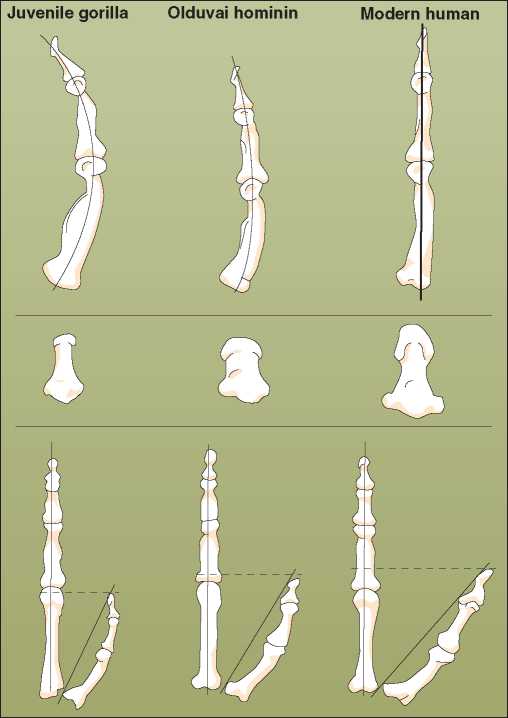
Figure 7.16 A comparison of hand bones of a juvenile gorilla, Homo habilis from Olduvai, and a modern human, highlights important differences in the structure of fingers and thumbs.
In the top row are fingers, and in the second row are terminal (end) thumb bones. Although terminal finger bones are more human, lower finger bones are more curved and powerful. The bottom row compares thumb length and angle relative to the index finger.
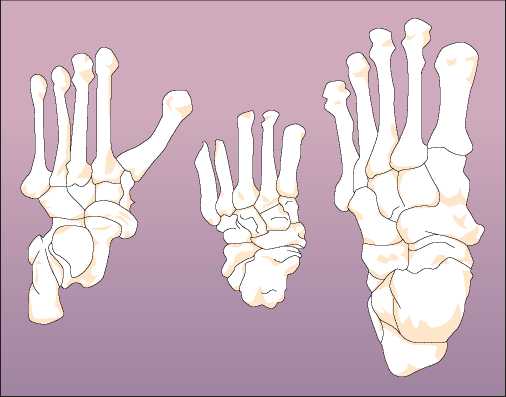
Figure 7.17 A partial foot skeleton of Homo habilis (center) is compared with the same bones of a chimpanzee (left) and modern human (right). Note how H. habilis’ bone at the base of the great toe is in line with the others, as in modern humans, making for effective walking but poor grasping.
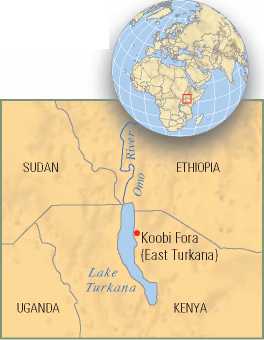
H. habilis as well. Since the late 1960s, fossils of the genus Homo that are essentially contemporaneous with those from Olduvai have been found elsewhere in Africa, such as South Africa, Ethiopia, and several sites in Kenya.
The eastern shores of Lake Turkana, on the border between Kenya and Ethiopia, have been particularly rich with fossils from earliest Homo. One of the best of these fossils, known as KNM ER 1470, was discovered by the Leakeys’ son Richard at Koobi Fora. (The letters KNM stand for Kenya National Museum; the ER, for East Rudolf, the name for Lake Turkana during the colonial era in Kenya.) The deposits in which it was found are about 1.9 million years old; these deposits, like those at Olduvai, also contain crude stone tools. The KNM ER 1470 skull is more modern in appearance than any Australopithecus skull and has a cranial capacity of 752 cubic centimeters (cc).
However, the large teeth and face of this specimen resemble the earlier australopithecines.
From this same site another well-preserved skull from the same time period (KNM ER 1813) possesses a cranial capacity of less than 600 cc but has the derived characteristics of a smaller, less projecting face and teeth (both of these specimens are shown in the photo on page 160). Though specimens attributed to H. habilis generally have cranial capacities greater than 600 cc, the cranial capacity of any individual is also in proportion to its body size. Therefore, many paleoanthropologists interpret KNM ER 1813 and ER 1470 as a female and male of a very sexually dimorphic species, with the smaller cranial capacity of KNM ER 1813 a reflection of her smaller body size (Figure 7.18).
Other paleoanthropologists do not agree with placing specimens as diverse as KNM ER 1813 and KNM ER 1470 in the single taxonomic group of H. habilis. Instead they feel that the diversity represented in these specimens warrants separating the fossils like the larger-brained KNM ER 1470 into a distinct coexisting group called Homo
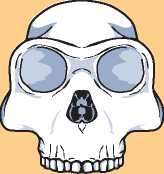
0 5 cm

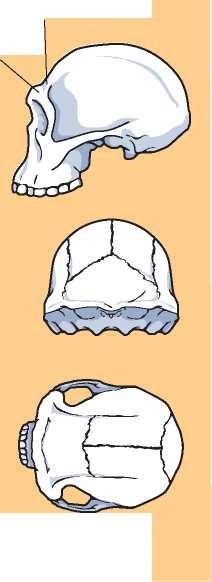
KNM ER 1813
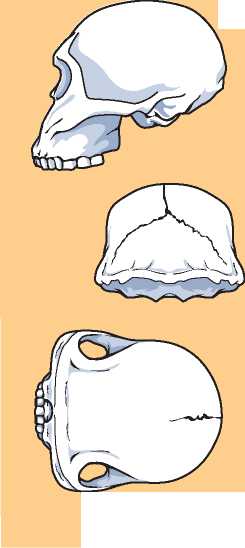
KNM ER 1470
Supraorbital sulcus Supraorbital torus
Figure 7.18 The KNM ER 1470 skull—one of the most complete skulls of Homo habilis—is close to 2 million years old and is probably a male; it contrasts with the considerably smaller KNM ER 1813 skull, probably a female. Some paleoanthropologists feel this variation is too great to place these specimens in the same species.
Rudolphensis. Whether one chooses to call these or any other contemporary fossils Homo rudolphensis or Homo habilis is more than a name game. Fossil names indicate researchers’ perspectives about evolutionary relationships among groups. When specimens are given separate species names, it signifies that they form part of a reproductively isolated group.
Some paleoanthropologists approach the fossil record with the perspective that making such detailed biological determinations is arbitrary and that variability exists within any group.103Arguing that it is impossible to prove whether a collection of ancient bones and teeth represents a distinct species, these paleoanthropologists tend to be “lumpers,” placing similar-looking fossil specimens together in more inclusive groups. For example, gorillas show a degree of sexual dimorphism that lumpers attribute to H. habilis. “Splitters,” by contrast, focus on the variation in the fossil record, interpreting minor differences in the shape of skeletons or skulls as evidence of distinct biological species with corresponding cultural capacities. Referring to the variable shape of the bony ridge above ancient eyes, South African paleoanthropologist Philip Tobias has quipped, “Splitters will create a new species at the drop of a brow ridge.”104 Splitting has the advantage of specificity while lumping has the advantage of simplicity. We will use a lumping approach throughout our discussion of the genus Homo.
Differences Between Early Homo and Australopithecus
By 2.4 mya, the evolution of the genus Homo was proceeding in a different direction from that of Australopithecus. In terms of body size, early Homo differs little from Australopithecus. Although early Homo had teeth that are large by modern standards—or even by those of a halfmillion years ago—they are smaller in relation to the size of the skull than those of any australopithecine. Early Homo also had undergone enlargement of the brain indicating that early Homo’s mental abilities probably exceeded those of Australopithecus. Early Homo likely possessed a marked increase in ability to learn and to process information compared with australopithecines.
The later robust australopithecines from East and South Africa that coexisted with early Homo evolved into more specialized “grinding machines” with massive jaws and back teeth for processing plant foods. Robust aus-tralopithecine brain size did not change, nor is there firm evidence that they made stone tools. Thus in the period between 1 and 2.5 mya, two kinds of bipeds were headed in very different evolutionary directions: the robust aus-tralopithecines, specializing in plant foods and ultimately becoming extinct, and the genus Homo, with expanding cranial capacity, a varied diet that included meat, and the earliest evidence for stone tool making.
Without stone tools early Homo could eat few animals (only those that could be skinned by tooth or nail); therefore, their diet was limited in terms of animal protein. On the arid savannah, it is hard for a primate with a humanlike digestive system to satisfy its protein requirements from available plant resources. Moreover,
22 Personal communication.
Failure to do so has serious consequences: stunted growth, malnutrition, starvation, and death. Leaves and legumes (nitrogen-fixing plants, familiar modern examples being beans and peas) provide the most readily accessible plant sources of protein. The problem is that these raw plants are difficult for primates to digest; substances in the leaves and legumes cause proteins to pass right through the gut without being absorbed unless cooked.23
Chimpanzees have a similar problem when out on the savannah. Even with canine teeth far larger and sharper than ours or those of early Homo, chimpanzees frequently have trouble tearing through the skin of other animals.24 In savannah environments, chimps spend about a third of their time foraging for insects (ants and termites), eggs, and small vertebrate animals. Such animal foods not only are easily digestible, but they provide high-quality proteins that contain all the essential amino acids, the building blocks of protein. No single plant food can provide this nutritional balance. Only a combination of plants can supply the range of amino acids provided by meat alone.
Lacking long, sharp teeth for shearing meat, our earliest ancestors likely foraged for insects, but sharp tools for butchering made it possible to efficiently eat meat. The initial use of tools by early Homo may be related to adapting to an environment that we know was changing since the Miocene from forests to grasslands (recall Figure 7.14).25 The physical changes that adapted bipeds for spending increasing amounts of time on the new grassy terrain may have encouraged tool making. Thus with the appearance of the genus Homo, a feedback loop between biological characteristics and cultural innovations began to play a major role in our evolutionary history. This set the human line on a steady course of increasing brain size and a reliance on culture as the means of adaptation, as we explore in detail in the next chapter.
23 Stahl, A. B. (1984). Hominid dietary selection before fire. Current Anthropology 25, 151-168.
25 Behrensmeyer, A. K., et al. (1997). Late Pliocene faunal turnover in the Turkana basin, Kenya, and Ethiopia. Science 278, 1589-1594.
24 Goodall, p. 372.
3. Who were the robust australopithecines? What evidence is used to demonstrate that they are an evolutionary dead end?
4. How do paleoanthropologists decide whether a fossil specimen from the distant past is male or female? Do our cultural ideas about males and females in the present affect the interpretation of behavior in human evolutionary history?
5. Do you think that members of the genera Ardipithecus and Australopithecus were tool users? What evidence would you use to support a case for tool use in these early bipeds?
Falk, D. (2004). Braindance: New discoveries about human origins and brain evolution—revised and updated. Gainesville: University Press of Florida.
In this updated and expanded version of her 1994 book, Falk presents her radiator theory to account for the lag between the appearance of bipedalism and the increase in the size of the brain over the course of human evolutionary history.
Johanson, D. C., Edgar, B., & Brill, D. (1996). From Lucy to language. New York: Simon & Schuster.
This coffee-table-sized book includes more than 200 color pictures of major fossil discoveries along with a readable, intelligent discussion of many of the key issues in paleoanthropology.
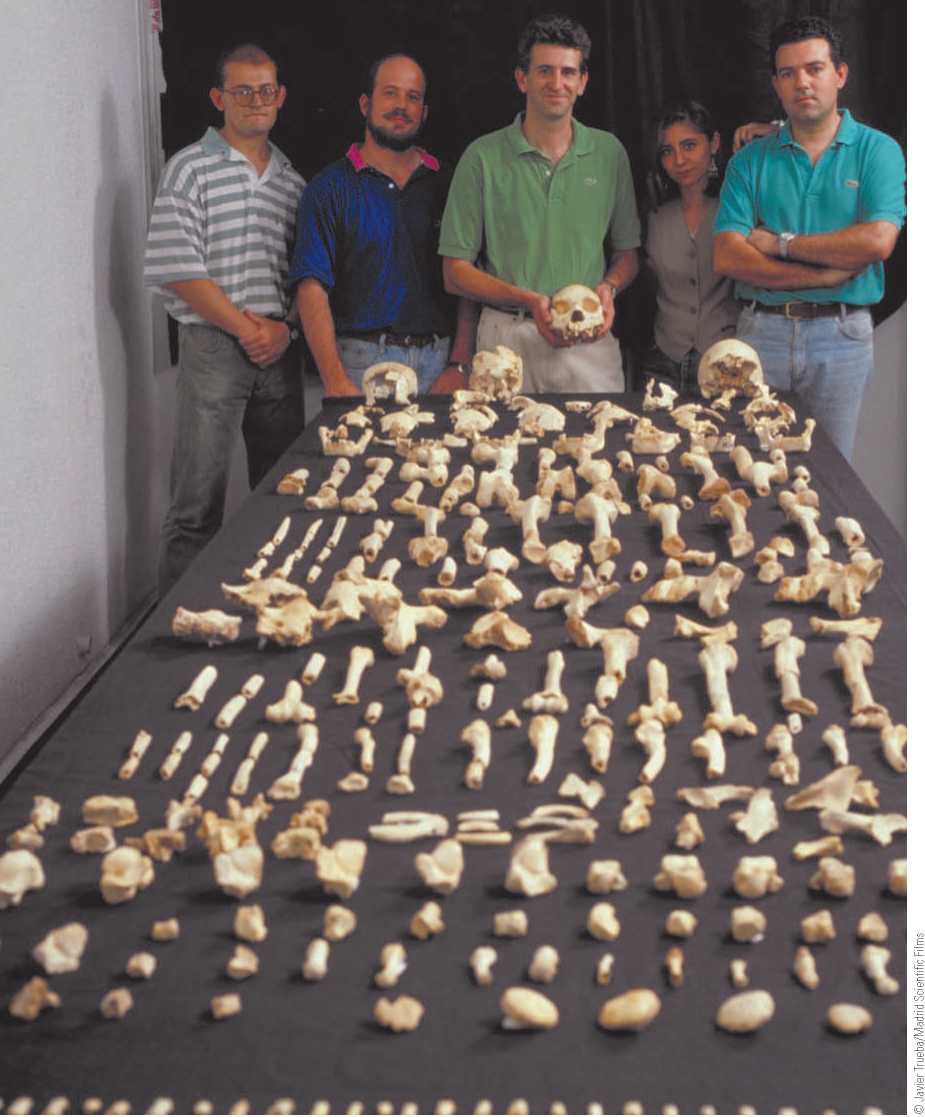
Challenge Issue With the appearance of the genus Homo 2.5 million years ago, our ancestors—with their increased brain size and emerging cultural repertoire—were better able to meet the challenges of survival. We know that without this brain expansion, reliance on culture could not have occurred, but we are not certain of the exact relationship between biological change and cultural capacity. Does each cultural innovation mark the appearance of a new species? Does a 20 percent increase in brain tissue do the same? And what about all the cultural changes that have occurred after brain size reached modern proportions? These fossils from Sima de los Huesos (“Pit of the Bones”), Sierra de Atapuerca, Spain, are an important part of the puzzle. They are the best collection of Homo fossils from a single site. Although the remains possess cranial capacities overlapping with the average size of contemporary humans, the scientists who discovered them place them in the species Homo antecessor. Dated to 400,000 years ago, these fossils fit into the complex period of our evolutionary history when brain size and cultural capability began to separate.
What Is the Relationship Between Biological Change and Cultural Change in the Genus Homo?
Paleoanthropological reconstructions of the culture and behavior of our ancestors are based on evidence about the environment; archaeological remains of tools, hearths, and shelters; and biological data about teeth, musculature, brain size and structure. Paleoanthropologists attribute the cultural change of making stone tools with the biological change of increased brain size because both appear at the same time in archaeological remains and fossil evidence. The fabrication and use of stone tools needed to crack open bones of animals for marrow or to butcher dead animals required improved eye-hand coordination and a precision grip. These behavioral abilities depended on the capacity to learn and communicate, which depended on larger, more complex brains. Once the brain size of genus Homo reached modern proportions between 200,000 and 400,000 years ago, the clear relationship between cultural capabilities and brain size uncoupled. Some fossil skulls retained a number of ancestral features, as well as some specialized features typically not seen in modern Homo sapiens. Archaeological evidence shows that cultures throughout the globe had become rich and varied. These ancient peoples produced tools for specific purposes and objects for purely symbolic use; they also practiced ceremonial activities and cared for the old and disabled.




 World History
World History









